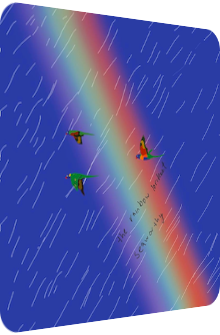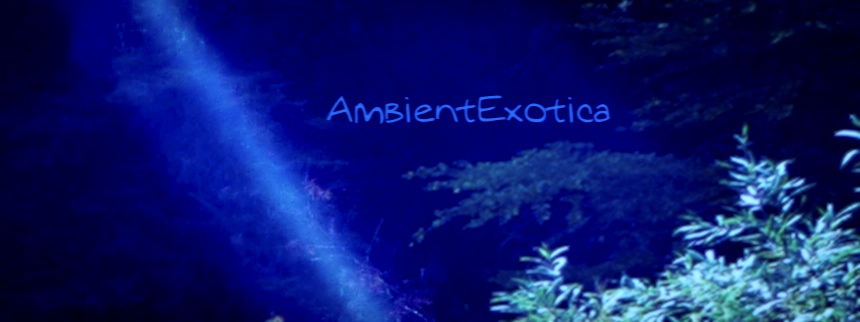
Seaworthy
The Rainbow Lorikeet
2013
The Rainbow Lorikeet is a long-form piece of roughly 20 minutes, envisioned by Sydney’s multi-instrumentalist, field recordist and environmental scientist Seaworthy aka Cameron Webb and fittingly released on Kate Carr’s Flaming Pines label as part of the Birds Of A Feather series which asks artists to write compositions of, about and around a specific bird of their choice. It is available to purchase directly at Flaming Pines and usually appears on Bandcamp about a month or two later. By the look of things, Webb’s choice is harmless and based on a broad agreement. Who could possibly hate or slate those vivacious animals, their technicolor feathers, rubicund beaks and beady-eyed alertness? Well, the question is easy to answer, as I have heretofore only described their physiognomy, so no, only histrionic villains would ever feel threatened by this species, right? There is – as usual – more to it, though: their high-pitched calls, alas, divide Sydneysiders, as does their quickly built flocks. These large groups cause riots and unchain cavalcades of noise. And since we are talking about a musical composition here, expect these vivid calls to appear as a preeminent leitmotif in The Rainbow Lorikeet. I do not know Webb’s attitude towards the bird, nor is it transparently mentioned in the liner notes, but I sense that he is somewhat fond of these little guys. The way he arranges his piece shows this better than anything: it is a panorama of lacunar parallax layers. Each texture is given its specific space and locale, and while they meet, mesh and depart constantly, the depth of field prospers due to this sun-kissed flurry and the well-balanced, quiescent undercurrent of sound, silence and sustain. Seaworthy sets up an utterly soothing state of languor. This is not per se surprising, especially not in the specific context of the Birds Of A Feather series, but it is rewarding to inspect how Seaworthy interweaves the rainbow lorikeet’s quirky liveliness in a tropical haze of veneered placidity. So without further ado, here is a meticulous look at The Rainbow Lorikeet.
Distant ocean waves, music box blebs, reversely played glockenspiel blotches and sun-soaked guitar chords greet the listener right from the get-go. Just one tiny minute into the intrinsic sanctuary of Seaworthy’s long-form piece, and it becomes clear what the artist accomplishes: a paradisiac, hammock-compatible and all the more devoted appraisal. Even without being a synesthete, one can literally smell the colors in this arrangement. The kalimba-oid pointillism conflates with an infinitesimally glacial legato afterglow of a metallic mallet instrument, all the while the mild acoustic guitar slaps augment the drowsiness. But where is the bird, the vulturine star of Cameron Webb’s beguiling composition? For the moment, it is amiss, allowing other birds to be in the limelight, but after approximately five minutes, a flock of lorikeets appears out of nowhere, resembling the "screaming gangs of teenagers running rampant through the local shopping centre on a sugar fuelled high" which the artist himself so aptly describes in the press blurb. Their chipper chirping is undoubtedly piercing and incisive, but at the same time emanates that sort of pitch and nucleic attribute which lets a human being believe that birds make this kind of noise due to insouciance and conviviality alone… or simply to gratify nearby onlookers. Right.
Of note is the aforementioned acoustic guitar which leaves its allocated layer and comes to the forefront around the eight-minute mark, showcasing its unexpectedly feisty attack rate in front of a scintillating glockenspiel airflow, traversed by spheroidal synth-like stardust helixes. A somnolent doldrums without a cloud (or lorikeet!) in the sky, this fugacious state is eminently relaxing. Soon, the paradoxically organic-mechanical drone mélange of the distant ocean waves sees its return, and so do our feathered friends. As the drone backdrop turns brazen and mechanic, with cars driving by on a nearby road, Seaworthy decides to turn things up a notch by featuring a field recording of particularly loudmouthed guttersnipes. Here is the description of a policeman: "They were coated in rainbows and sported a braiding of feathers. Transmisison over." In this last third of The Rainbow Lorikeet, it becomes clear how astute a description Webb delivered. The fusillade of chattering hits the listener like a shrapnel of staccato scythes, and only the geographic location and personal background prevent him or her from covering the face or rolling the eyes. In this very moment, no matter its shortness or ephemerality, Seaworthy willfully annihilates the cautiously maintained balance.
It is easy to dismiss this momentary shift as gimmicky, but in an – admittedly much more benignant and good-natured – way, it resembles the horrific energy of Gail Priest’s The Common Koel (2013), a bird whose nasty cry reverberates through a mucoid swamp of emptiness. How frilly and flattering The Rainbow Lorikeet is by comparison! Even this brief protrusion cannot abate one’s principal love for these rascals. Besides, even if this were indeed the case and a typical Sydneysider (whoever this person may be) would be all too willing to badmouth the bird, Seaworthy launches the sunset phase anyway, again resembling Priest’s mentioned ode – or diatribe? – to the common koel by decreasing and cauterizing the background. It fades out for good and leaves the, now well-known, acoustic guitar aorta all by itself. Now that it is placed in a pith of nonentity, its colors become sanguine-rufescent, the strings are coated in reverb. The day winds down, the birds are asleep, but even in this quietest of all phases, the clemency and placidness Cameron Webb shows for his chosen species is harbored in each and every lick. One might dismiss this transfigured rurality as rusticity, for these terms sound alike, with their connotations being analogical in one way or the other, but the endpoint of The Rainbow Lorikeet does not need to be propitiatory, Seaworthy is not guilty of anything, nor is the bird. It not only fits the overall tone, it also allows the listening subject to press repeat… and experience an instrument-accompanied dawn chorus that manifests itself much quicker than the majestic sunset phase of contemplation and peacefulness.
I am a big Exotica fan, no surprise at all, so I am of course lured by Seaworthy’s rich alluvial breezes and their quiescent aftermath. The whole setting is so colorful, glorified and jungular, but does not rule civilization out completely as the passing cars show. And yet, from an aesthetical viewpoint, one has to ask whether Cameron Webb has chosen the easy way out. Take Marcus Fischer’s The Crow (2013) and Gail Priest’s said The Common Koel, and it becomes clear that their compositions are much more ambiguous, even on the diametrically opposite sides of the scale: whereas Fischer creates an enchanting piece of a hated bird which he watches from his studio, Gail Priest’s piece does not reveal whether she mocks the medulla-emptying sharpness of the koel’s scream or secretly adores the feathered plague. Seaworthy’s The Rainbow Lorikeet does not pose such questions, which is, at least to me, fair and square. It is a piece about paradise, if not for Sydney’s citizens, then all the more so for the rest of the world. Webb’s minimization of the problem about an occasionally pesky bird is stupefyingly adorable. Iridescent and flamboyant like the bird’s plumage, The Rainbow Lorikeet prefers to meander through its motifs and recurrent layers instead of frantically twirling to the next exciting destination. It is exactly what I demand of electro-acoustic Ambient compositions that are set in the Tropics or their warm surroundings. The Birds Of A Feather series always unites a glaring disadvantage with a unique boon: what sounds mundane at best and nerve-racking at worst to the locals is suddenly open to scrutiny, globally speaking. The Rainbow Lorikeet does unleash its fair share of hysteria, but Seaworthy’s mellifluous thicket of sylvan tendrils, strings and mallet instruments washes any skepticism away.
Further listening and reading:
- The Rainbow Lorikeet is available to order at Flaming Pines.
- Seaworthy’s and Flaming Pines’ Twitter handles are @woodenpalace & @FlamingPines.
Ambient Review 308: Seaworthy – The Rainbow Lorikeet (2013). Originally published on Jan. 22, 2014 at AmbientExotica.com.
